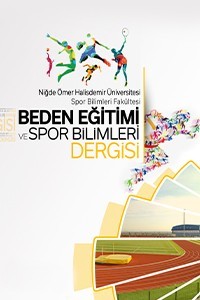EFFECT OF GENDER DIFFERENCE AND CIRCADIAN RHYTHM ON TOTAL MOOD DISTURBANCE OF VOLLEYBALL PLAYERS
EFFECT OF GENDER DIFFERENCE AND CIRCADIAN RHYTHM ON TOTAL MOOD DISTURBANCE OF VOLLEYBALL PLAYERS
___
- 1. Anita, V., Clark. Causes, role, and influence of mood states. New York: Nova Publishers. 2005
- 2. Claude Bouchard, Stevel, N., Blair and William, L., Haskell. Physical activity and health. United States: Human Kinetics. 2007
- 3. Colley, A., Nash, J., O'Donnell, L., & Restorick, L. Attitudes to the female sex role and sex-typing of physical activities. International Journal of Sport Psychology, 1987; 18, 19-29.
- 4. Csizma, K. A., Wittig, A. F., & Schurr, K. T. Sport stereotypes and gender. Journal of Sport and Exercise Psychology, 1988; 10, 62- 74.
- 5. Daniel, M., Martin, A. D., and Carter, J. Opiate receptor blockade by naltrexone and mood state after acute physical activity. British Journal of Sports Medicine, 1992; 26: 111-115.
- 6. Dawm, P., Lemcke, Julie Pattison, Lorna, A., Marshall and Dieborah, S., Cowley. Current Care of Women. Columbus: Hill Professional Publisher. 2003.
- 7. Duffy, J. F., Rimmer, D. W., & Czeisler, C. A. Association of intrinsic circadian period with morningness- eveningness, usual wake time, and circadian phase. Behavioral Neuroscience, 2001; 115, 895-899.
- 8. Jim Reeves Silent Night, D. Influence of Circadian Rhythms on Selected Physical, Physiological and Psychological variables. Unpublished Ph.D Thesis, Alagappa University, Karaikudi. 2003.
- 9. Koivula, N. Ratings of gender appropriateness of sports participation: Effects of gender-based schematic processing. Sex Roles, 1995; 33, 543-557.
- 10.Laurin, C., Lavoie, KL., Bacon, SL., Dupuis, G., Lacoste, G., Cartier, A., and Labrecque, M. Sex differences in the prevalence of psychiatric disorders and psychological distress in patients with COPD. Journal of Chest, 2007; 132(1): 148-55.
- 11.Matteo, S. The effects of sex and gender-schematic processing on sport participation. Sex Roles, 1986; 15,417-432.
- 12.Michelle, P., Warren and Naama, W., Constantini. Sports endocrinology. United States: Humana Press Publisher. 2000.
- 13.Roberta, K., Oka, Andrzej Szuba, John C., Giacomini and John P., Cooke. Gender differences in perception of PAD: a pilot study. Journal of Vascular Medicine, 2003; Vol. 8(2): 89-94.
- 14.Ruth, F., Craven and Constance, J., Hirnle Fundamentals of nursing: human health and function. Philadelphia: Lippincott Williams & Wilkins Publisher. 2006.
- 15.Taylor, Reis, Sausen, Padilla, Markham, Potterat and Drummond. Trait anxiety and salivary cortisol during free living and military stress. Aviation Space and Environmental Medicine, 2008; 79(2): 129-35.
- ISSN: 1307-6477
- Yayın Aralığı: Yılda 3 Sayı
- Başlangıç: 2007
- Yayıncı: Niğde Ömer Halisdemir Üniversitesi
Tülin ATAN, Pelin AKYOL, Osman İMAMOĞLU
TÜM BEDEN VİBRASYON ANTRENMANININ NÖROFİZYOLOJİK ETKİLERİNİN İNCELENMESİ
EFFECT OF GENDER DIFFERENCE AND CIRCADIAN RHYTHM ON TOTAL MOOD DISTURBANCE OF VOLLEYBALL PLAYERS
GENÇ ELIT GÜREŞÇILERIN FIZIKSEL VE FIZYOLOJIK ÖZELLIKLERININ KARŞILAŞTIRILMASI
Erkan DEMİRKAN, Rafet ÜNVER, Mehmet KUTLU, Mitat KOZ
TÜRK ANTRENÖRLERININ MESLEKI BENLIK SAYGISI DÜZEYLERININ İNCELENMESI
Yunus YILDIRIM, Hüseyin KIRIMOĞLU, Gülşen Fizlazoğlu ÇOKLUK
İbrahim CİCİOĞLU, Özlem ORHAN, Çağrı ÇELENK
RAFTİNG KATILIMCILARININ RAFTİNG KAVRAMINA İLİŞKİN METAFORİK ALGILARI
Erkan Faruk ŞİRİN, Fatih BEKTAŞ, Gülsen KARAMAN, Gonca Korucu AYTAN
BİREYSEL VE TAKIM SPORU YAPAN SPORCULARIN BAZI FİZİKSEL UYGUNLUK ÖZELLİKLERİNİN KARŞILAŞTIRILMASI
